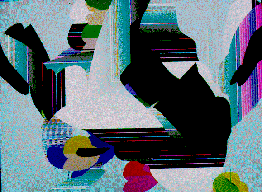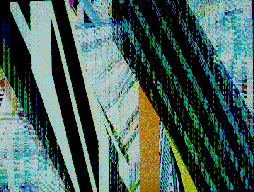



I began to write programs which create kinetic abstractions during 1984. Kinetic, because they are programs which run for several minutes creating an imagery of abstraction in motion. I began to program because I was dissatisfied with drawing and painting software. The computer's potential as a medium for painting is much more exciting than off-the-shelf software.
I had never studied computer science or programming but began to teach myself immediately. It was not painful. I was deeply absorbed. I began with logo on an apple and felt amazement at the development of an abstract image right before my eyes. I kept repeating it. I moved on to basic on the Amiga in 1986 and could not peel myself away from the pleasures of creating images which not only moved but made sound. I also programmed the sounds. Some of my friends loved the images but hated the sounds. Some friends thought that I had relinquished artistic judgment to a machine.
In time I learnt to program in C. It was not hard. It was merely the insanity of fascination. I had clear ideas about abstract form in painting and intuitively recognized the potential for expanding this new twentieth century visual language through the computer. I am definitely not interested in three dimensional illusion. I am often told that I might expand my language by using 'more advanced technology'. These critics tell me that I should scan some three dimensional images and add them to my abstractions.
I am too polite to tell them that they do not have the mind and the eye to see that that is not more advanced but rather more backward. I seek to expand a radical new language in art. I do not feel impressed by three dimensional software or by scanning photographs. I can draw well enough and render in traditional academic ways. That is fine. But in painting as in science we are nothing if we do not push forward the boundaries of our knowledge.
I have made a careful evaluation of the history of pictures to assure myself that I make no errors of judgment. Examining history has always been an integral part of my artistic work from the very beginning. I think ray tracing is an extremely useful and appropriate extension of Renaissance perspective. It has aided the production of those materials we need for living. But for painting as a vanguard activity ray tracing is old hat. There are newer formal ideas. It is not the computer's ability to imitate optics that I find fascinating.
Beside an intellectual persuasion I feel a genuine and palpable disappointment when a three dimensional image breaks down the illusion created by an abstract space which in reality is a four dimensional illusion.
I want to develop visual ideas on speed differentials. I look at the world around me and I see that things move at different speeds visually in relation to each other and to me. I wish to extract general principles of motion based on these observation and apply them to my paintings. The computer, as a digital media, has allowed me to deepen visual ideas of form and illusion not easily possible otherwise.
So these paintings which I call KINETIC COMPUTER PAINTINGS are in fact programs which run on a computer and create sounds. The sound is an important new idea as an adjunct to abstract form. As things move they also make sound.
Recently, while watching musicians jam at a SCAN (Small Computers in the Arts Network) conference, I decided that I will write a program which will enable me to perform a painting live in collaboration with musicians. I did so and have been performing paintings along with musicians. We jam sound and abstract image.